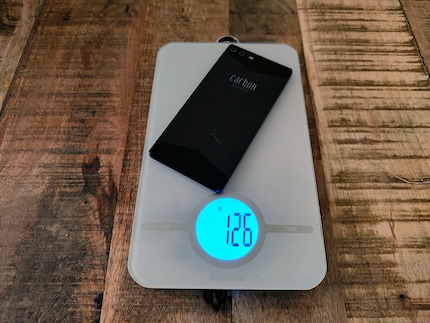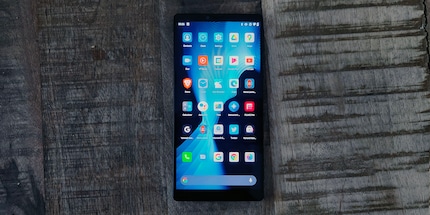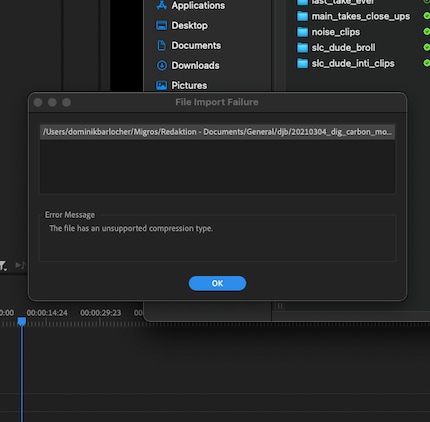
Carbon Mobile 1 Mk II: don't buy this phone
What a disappointment. The Carbon Mobile 1 Mk II was announced loud and proud, but it’s junk through and through. Except for the carbon back, which is definitely worth a closer look.
«An article from you about Carbon Mobile would be interesting,» user Nimrod87 writes in the comments.
«Vaporware,» I think to myself. Something that was announced in a big way, but then never made it to market. Carbon Mobile, a German manufacturer with roots in the United Arab Emirates, has been creeping around the tech world since 2016. I remembered some smartphone being shown at trade shows. Journalists had even held it in their hands. But there was never anything on the market.
Hence: vaporware.
Three days later, I found a Carbon Mobile 1 Mk II in my mailbox.

I wish this thing had stayed vaporware. Because aside from the carbon, the thing is junk.
How I learned to hate the Carbon Mobile 1 Mk II
The Carbon Mobile 1 Mk II weighs 126 grammes. One hundred and twenty-six. That’s mighty little. Carbon Mobile is thrilled to tell you that this is because of the carbon. After all, carbon is lighter than glass or metal. That’s true. Despite my strong desire to bash the Carbon Mobile against the wall, I don’t actually want to destroy it. As luck would have it, I had taken apart an old iPhone 11 Pro Max last year. The iPhones battery weighs 57 grammes; its total weight is 228 grammes. The backplate – the part that’s made of carbon in the Carbon Mobile – weighs 80 grammes.

But Carbon Mobile didn’t save weight only through the material on the backplate. The battery’s also smaller. We can even calculate how heavy the battery is in the 1 Mk II (assuming it makes sense to calculate it this way). The 57-gramme iPhone battery has 3,969 mAh. The Carbon Mobile battery has 3,000 mAh.
57/3969*3000 = 43.0839002268
According to this calculation, the Carbon Mobile battery should weigh around 43.1 grammes, or about a third of the phone’s total weight of 125 grammes. I expect this to be quite accurate, since both phones rely on essentially the same battery technology. This calculation doesn’t work with the system-on-a-chip (SoC), on the other hand. Because where the iPhone 11 Pro Max has an up-to-date A13 Bionic built in, Carbon Mobile decided to opt for stone-age technology.
The built-in MediaTek Helio P90 was introduced in 2018 as an upper mid-range SoC. Here’s what I’m getting at: your toaster probably has more computational power than the Helio. And it didn’t cost you 800 francs.
That’s what made me increasingly angry the longer I tested the thing. How dare a manufacturer charge such outrageously high prices for something that has the performance of an electric toothbrush, at best?
But wait, there’s more. The Helio is so outdated that it eats up power without end. Other manufacturers build their SoCs using the 5nm process. As a rule of thumb: the smaller the number before the nm, the better the battery life. The A13 Bionic runs on 7nm, the current A14 Bionic runs on 5nm. The Helio P90 runs on 12nm. Twelve.
But, to be fair, the battery lasts forever anyway. Because as soon as you start using the Carbon Mobile 1 Mk II, you simply lose all desire to continue using it. Even if you can put up with the sorry hardware and the gaping hole in your wallet.

And then the cherry to top all that off: Carbon Mobile doesn’t quite seem to be sure what the hardware in their own phone is called. Sometimes, they write «MediaTek» on their website. Other times, «MEDIATEK». And until just a few days ago it was even «ediatek» somewhere, without an M.
Software from hell
When you, an Android phone manufacturer, build a smartphone, you invest large parts of your budget in the hardware. Good, because that’s how you ensure performance. Now, Carbon Mobile certainly has to invest more, because not yet many factories can produce the carbon backplate. This makes the manufacturing process more expensive. In terms of software, Google provides a universal, Google-maintained Android distribution – Android One. It’s easy to update and looks chic. All a manufacturer has to do is ensure a few interfaces are Android One compliant.
Not Carbon Mobile.
Nope, the German-Arabic manufacturer must have thought it’s not so difficult to create a proprietary Android distro – because that’s exactly what Carbon Mobile did. The distro doesn’t look bad at all. Black and blue, pruned to look chic. You turn on the phone, install a few apps and quickly realise that they all show up to the right of the home screen. Fair enough, every Android distro does that. You don’t want them there, so you delete them from the second screen.

Two minutes pass... and they’re back!
The damn Carbon Android doesn’t allow you to remove apps from the second home screen. I think back to my HTC Desire from the year 2010. It ran Android 2.2 and could do this. Carbon Mobile has hosed Android 10 so well that this eleven-year-old functionality no longer works. Assuming there’s a normal development process in place, how badly did the internal software test have to fail to allow it to be released? And for 800 francs, no less.
The nerve of it!
A camera from 2013
Speaking of nerve, look at the pictures taken with the Carbon Mobile 1 Mk II.

See the full-resolution image here.
And for comparison, the same picture taken with the camera on the Oppo Find X3 Pro – a true flagship. The tripod in the same spot. All settings are at default.

See the full-resolution image here.
And Carbon Mobile is proud of it, too. «Take photos like a pro» is what it says on their German website, which is actually in English with a few exceptions. For the record, writing «Über» instead of «About» doesn’t render a website German. This might have something to do with the fact that Carbon Mobile is not really a German company. Carbon Mobile has international origins, not really belonging to any single nation. Carbon Mobile then simply found fertile ground for its start-up in Germany. There’s nothing wrong with that. But apart from the marketing blurb «Born in Germany», which doesn't really mean anything, there’s not much Deutsch-ness to be found on the website.
Regardless, you’re supposed to be able to take pictures like a pro. But a camera test done in the same valley where I tested the Oppo Find X3 Pro makes clear what Carbon Mobile means by «pro».
Potato cam.
I think back to my HTC M8 from the year 2014. The images are about the same in terms of quality.
It gets even more scandalous when you try out the video function. The camera is doing something very wrong to the background. And no, that’s not the camera shaking. The phone is on a Manfrotto BeFree tripod and I’m about a metre away.
Note from video journalist Stephanie Tresch while editing the footage: the video above is so poorly encoded that Adobe Premiere Pro can’t simply import the file. Before she could work with the video, she had to put it through the video converter built into VLC Media Player. It’s slow and inefficient, but will eat up just about anything you throw at it....

Like a pro. Right. Clearly.
But: carbon!
When all is said and done, you get a phone with a really cool backplate. Carbon is an extremely strong material that can be formed into any shape with little effort. Just make a mold, pour in carbon, done.
However, carbon is an electrical conductor and acts as a shield. Not good if building a device that relies on radiation. Without data and cellular reception, your smartphone isn’t much use to you. In the German daily newspaper Tagesspiegel, Firas Khalifeh, CEO of Carbon Mobile, was quoted as saying his company had managed to circumvent the so-called Faraday cage created by carbon.
The new carbon phone contains parts made of a new type of „radio-capable
Niccholas Vettiger of SLC Motobikes manufactures carbon parts for motorcycles in his start-up in Wetzikon, Zurich. He has an ETH bachelor’s degree in mechanical engineering, and personally touches every part that gets screwed onto a Harley or installed into Yamaha.

Source: zVg
Niccholas notes one thing: «The Faraday cage can’t be circumvented. It blocks electric fields, which is based on physical quantities that no one bypasses that easily.»
He quickly dismisses his initial assumption that Khalifeh used a different matrix to hold together the carbon fibres. According to Niccholas, it’s possible, but too fussy. However, a look at the backplate and its interesting design seems to explain this.
«The black parts – the ones without the pattern – are probably not made from carbon. This would mean there’s no Faraday cage, and radiation can flow freely through the backplate.»
Technology that will hopefully be for sale
I hope Carbon Mobile gives up. I hope that Firas Khalifeh and his crew throw in the towel and sell the carbon backplate technology to someone who really knows smartphones – and doesn’t dare spread fibs on their website.
If you got carried away by the marketing and great «win a bike to go with it» contest, please return the phone. You’re better off investing in a carbon part for your bike. You’ll certainly get more enjoyment out of it.
Since a phone as bad as the Carbon Mobile 1 Mk II, is a rare occurrence, I asked the manufacturer for a comment shortly before publishing this review. I will, of course, let you know what Carbon Mobile has to say.
Journalist. Author. Hacker. A storyteller searching for boundaries, secrets and taboos – putting the world to paper. Not because I can but because I can’t not.


